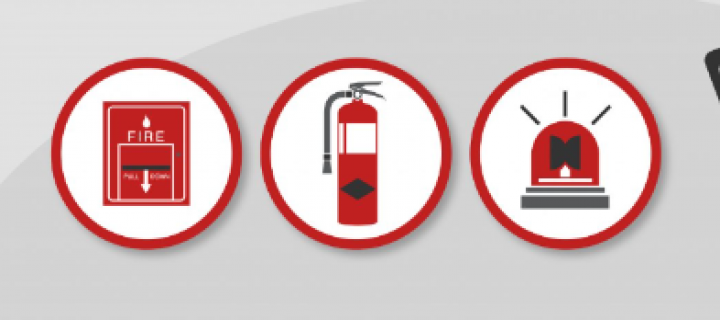How to Maintain Your Fire Safety Equipment
Under the terms of the Regulatory Reform (Fire Safety) Order 2005, all commercial premises nationwide must be fitted with the appropriate fire safety equipment.
Whilst you may assume that your obligation ends once the correct equipment is installed, this is not the case; all fire safety equipment should be regularly maintained to guarantee its effectiveness when you really need it.
But just how do you maintain your fire safety equipment? And who is responsible for this crucial duty? The team here at TVF (UK) Limited is here to answer all your questions.
Who should maintain your fire safety equipment?
All commercial premises must have a designated ‘responsible person’ for the building; this can be a landlord, building manager or an employer if the building is a workplace. It is their duty to ensure that maintenance work is carried out by a qualified professional on a regular basis. Should your premises be found without properly functioning fire safety equipment, the responsible person may be subject to severe financial penalties, or even a custodial sentence in cases of extreme negligence.
How often should your fire safety equipment be maintained?
All fire safety equipment will have different recommended schedules for inspection, so it’s important to check the specific guidelines for each piece of apparatus. However, under the terms of the Regulatory Reform (Fire Safety) Order 2005, an annual fire risk assessment must be performed at all commercial premises. During this inspection, potential hazards will be identified and your fire safety equipment should be examined to ensure it is still in good condition — further maintenance may be recommended if faults are identified.
How to maintain fire alarms
BS 5839 guidelines recommend that all fire alarm systems are inspected bi-annually to check for any signs of damage, however, high-risk buildings may require more frequent work. During this assessment, all panels, circuits, call points and detectors should be meticulously tested to ensure proper function, and if any faults are identified then these must be rectified immediately.
Weekly fire alarm tests are also advised to make certain that the alarm can be heard in all areas of the building. Your alarm units should also be cleaned frequently, as dust and dirt can impede performance and cause false alarms.
How to maintain fire extinguishers
Whilst all fire extinguishers require an annual inspection, they must also have an extended service performed every few years. The frequency of this is determined by the kind of extinguishers that you own; for water, powder, wet chemical and foam fire extinguishers, this must occur every five years. This extended service must be performed by a qualified fire safety professional to ensure it has been executed properly. During this survey, the extinguisher will be inspected for faults, before being discharged, re-filled and then re-pressurised. Outside of scheduled maintenance work, you should also refill fire extinguishers immediately after each use.
CO2 extinguishers withstand much higher pressure than regular extinguishers, therefore they only require maintenance every ten years. This is a thorough survey called an ‘overhaul’, in which the primary valve will be completely replaced before a hydrostatic pressure test is performed. This test will ensure that your extinguisher can endure its pressure rating and verify there are no stretches or cracks that could threaten its integrity.
How to maintain fire doors
To work effectively and prevent smoke infiltration, every fire door in your building should be fitted with smoke seals and a self-closing mechanism. These must be regularly inspected — at least every six months, or more frequently if located in a high-traffic area — and replaced immediately if they are found to be defective. The closer and hinges must also be frequently examined and lubricated to ensure smooth operation.
How to maintain emergency lighting
To prevent the panic and confusion of evacuating in pitch darkness, your emergency lighting system must be tested regularly. A ‘flick test’ should be conducted monthly, where a power failure is simulated to ensure all lights are still functional. Under BS 5266 standards, an annual service must also be performed by a qualified fire safety technician. During this test, the primary lighting circuit must be switched off and emergency lighting used exclusively for three hours to identify any faults.
How to maintain sprinkler systems
Under BS EN 12845 guidelines, your sprinkler system should be inspected every quarter, with the sprinkler heads, pipework and pipe supports examined and a flow test carried out. A hazard review should also be conducted by a third party to ensure there have been no changes to the layout, structure or occupancy of the building.
On an annual basis, there should also be an inspection and service of the pump, engine and valves. Your pipe system may also need to be alternated from air to water or vice versa. This is largely dependent on the season; for example, switching to air in the winter months will prevent your pipes from freezing. Furthermore, every ten years, the tanks of your sprinkler system should be drained, cleaned and thoroughly inspected, both internally and externally.
Here at TVF (UK) Limited, our BAFE-accredited fire safety experts are equipped to perform repair and maintenance work on all fire safety equipment. Whether you need assistance recharging fire extinguishers or your staff requires additional fire safety training, we can help ensure that your premises is compliant with all UK regulations.
For more information regarding our services, contact our friendly team today. We operate throughout High Wycombe, Watford, Slough and beyond.













